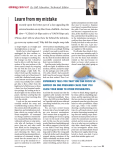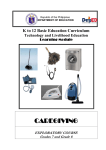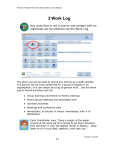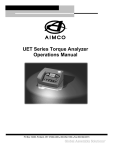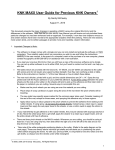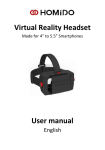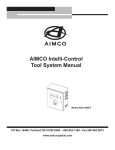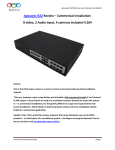Download LTC Newsletter 02_2011.indd
Transcript
ISSUE 2 FEBRUARY 2011 LTC PROFESSIONAL N E W S A N D V I E W S YO U C A N R E A L LY U S E THE ADELMAN ADVANTAGE by Rebecca Adelman KESSLER’S CORNER CRISIS COMMUNICATIONS FOR PROVIDERS – ARE YOU READY? Part II In Part I of this article, the importance of sound crisis communications was the focus. We identified possible crisis scenarios, designation of a Crisis Team and the responsibilities of team members. In Part II, we discuss communications during the crisis and creating the crisis communications plan. Crisis Communications Plan Contacts and Notification – As part of your Crisis Plan Manual, include an updated Contact List of team members. Officers and senior management should be the first to be notified. If the crisis calls for immediate contact with media, the Chief Communications Officer should notify personnel who may be in contact with the media and public and advise them how to respond. The internal notification protocols will vary with each organization but generally should be coordinated through one crisis team member pursuant to the plan that, by the time the crisis arises, should have been tested on a regular basis. Consider key internal and external audiences in your notification plan which may include Agencies (Federal, State and Local), Attending physicians, Board members, Elected officials, Employees, Families/Next-of Kin and Referring discharge planners and hospitals. Use telephone banks, voice mail, email, personal visits, facsimile, intranets, the organization’s website, social networking sites (Facebook, MySpace, Twitter etc…), outside websites, blogs and traditional media as communication tools. Communicating to Employees – How messages are delivered to employees will influence the way employees then communicate with residents, families, the public and each other. When notifying employees of a crisis event: convey the facts and confirm that everyone understands them; be in control; and provide updates. Key information includes a brief summary of the facts, an explanation of the cause, the steps being taken in response, how long it is expected to last, acknowledgement about emotional impact, identification of the Crisis Team, identification of the lines of crisis communications and a commitment to maintain internal communications. The Crisis Communications Plan - A “Top 10 Vulnerabilities Audit” is a list of crisis scenarios that could occur in your organization. Individuals in the organization should be interviewed and questioned about crisis preparedness. Interviews should be conducted with key executives, managers and staff. After you have made a list of the crisis scenarios, it is recommended that you rank them in order of their probability of occurring. Develop crisis plans for the “Top 10” on the list. Conducting the vulnerabilities audit will allow your organization to develop a sound business crisis plan with strategies designed to reach the stakeholders with information on the crisis before they hear about it from the media or other sources. When developing a crisis Adelman Advantage continued on page 2 by Chip Kessler Customer Service: The Art of Making Amends This column is going to be very open in regards to the way I run the day-to-day business of our company Extended Care Products, and how you can apply a couple of principles I use to offer even better customer service to your nursing facility’s residents and families. Let me add here that our clients are people like you – those that either work in a nursing facility, or are associated with nursing facilities (because you are with a management company, ownership group, insurance company, law firm, or a risk management company). So you may be asking, “okay, how does customer service (or the lack thereof) come into play in your business?” Indeed it does in any number of ways, however, no more so than when we screw something up from our end. An example: just the other day a nursing facility client called to inform me that while we sent him the correct program he ordered, we included the wrong invoice with the shipment, and to further our embarrassment, Kessler’s Corner continued on page 3 LTC PROFESSIONAL TIP-OF-THE-MONTH... How to Best Handle the Automated Telephone System by Nancy White In an ideal world, a nursing facility (or any type of healthcare or service related business) would not use an automated voice forwarding system. Why? Because we’ve all experienced the dreaded “punch in this number for this” and the “punch in this number for that” syndrome, when all we want to do is speak to a real live person. This can be bothersome enough when we call about a charge on a credit card or need to talk to someone at the dentist’s office … let alone when the person on the other end of the telephone is wrestling with the decision of potentially placing a loved one in a nursing facility, or is calling our building because they have a question about a caregiving issue concerning a resident already staying with us. Again, all this person wants to do is speak with the administrator or the director nursing or some other staff member ASAP, and now they have to navigate a series of prompts to hopefully get there. To be frank, there’s nothing good about this from a customer service or a census building standpoint. So the question is: how for our nursing facility to make the best of this situation? Here are some suggestions: 1) Make sure your automated system is as user friendly as possible. Here you want easy to understand and easy to follow directions. 2) Streamline the process. The fewer prompts the better. Accordingly when the caller is asked to push “three for the administrator” this action should result in the caller then getting through to the administrator’s line and not another person (or voice prompt) in your office. 3) Being aware of and regularly check your voice messages. As you well know, working in a nursing facility means you’re constantly on the go! You’re not chained to your desk so it’s a fact of life that you’re going to miss calls. Thus, you must constantly be of a mind-set to check your messages when you return to your office, and most importantly to immediately return your phone calls … even though there may be any number of other people or things vying for your attention. Sometimes it’s easy to put returning phone calls off this since the man or woman who’s left you a message is just a “voice on the phone” and not a thing needing a resolution or a person right in your face looking for an answer. Naturally when returning that call, you want to apologize for not being there to initially take it … then get to work on dealing with the telephone caller’s question(s) and/or needs. Nancy White is customer service representative for several nursing facilities in the southeastern United States. Her main responsibility is in speaking with families about their satisfaction with the care and services their loved one is presently receiving in a client’s facility. Adelman Advantage continued from page 1 communications plan for the “Top 10” list, consider questions that relate to the potential impact on the organization’s reputation and political and legal consequences such as: What is the threat to the organization’s reputation? What can the organization do to make the response/ reaction positive and favorable? What are the possible political or regulatory effects from the crisis? Could a lawsuit or other investigation result from the crisis? The Components of the Plan - Your organization must complete a manual that will serve as the central Crisis Communications Plan. The manual will coordinate the notification of the crisis team and other audiences including the media. The plan should include prepared key messages for designated team members to convey to the media for the duration of the crisis. The plan should reflect the following qualities and be: Simple - individuals and teams should be able to understand their roles and responsibilities in a clearly written plan; Easy – individuals and teams should be able to easily execute the plan; Specific – the roles of individuals and teams should be well-defined and clear; Immediate – a sound plan can be implemented immediately; Flexible - the plan should contain some contingencies that include a supplemental team; and Integrated – as earlier discussed, the plan should be a part of an organization’s disaster preparedness and risk management plans. In Part III, we will examine the plan’s main messages and crisis strategies and the post-crisis phase. Rebecca Adelman, Esq. – Ms. Adelman is the Principal of Adelman Law Firm, PLLC in Memphis, Tennessee and has concentrated her practice in healthcare, and nursing home and medical malpractice defense litigation for the past 22 years. She also provides medico-legal consulting services and educational programming to the healthcare industry. She is licensed in Tennessee, Mississippi, Arkansas and Illinois. The firm is proud to be of counsel to Quintairos, Prieto, Wood & Boyer, P.A. and together provide services to our national and regional clients. Adelman Law Firm, PLLC 545 South Main Street, Memphis, Tennessee 38103 Phone 901.529.9313 [email protected] MDS 101 (1) T h e Resident Assessment Instrument (RAI), including the Minimum Data (MDS) Set 3.0, is a challenging and often complex process for everyone involved, even for the seasoned professional. So, for the novice MDS nurse who is in the throes of learning the nuts and bolts, it can seem overwhelming, even impossible. That was my experience 11 years ago as I began my journey into the world of the RAI. I was given a copy of the MDS 2.0 RAI User’s Manual, told to read it, and after 3 very sporadic and confusing days of training by the outgoing MDS nurse, I was on my own. Before this I felt pretty confident as a nurse. But on that day, it felt like I didn’t know anything. I found myself asking, “What have I gotten myself into”? But, as time passed, and the nightmares became less frequent, I began to gain a level of confidence working the new assessment tool I had been assigned. Before long, I came to appreciate it for the value it brought to our systems how much better we as a team could care for our residents having had to complete the RAI. By Joel VanEaton For those of you who are new to working the RAI, let me encourage you to stay the course. It may not seem like it now, but you are at the forefront of a highly specialized field and are helping to lead your team to more resident centered compassionate care. I applaud you for this and want you to succeed. So, for the next few months, we will work together with a view to providing you with some practical information that will help you in your new endeavor. For those of you who have been at this for a while, a review of the basics is always a good thing. I would like to start by reminding you all that as complicated as the RAI seems right now, it is really just the Nursing Process that you learned in nursing school. Remember ADPIE, (Assess, Diagnose, Plan, Implement, Evaluate)? It’s the RAI in a nutshell. Assess = the MDS 3.0, Diagnose = the CAA’s, Plan = Care Plan, Implement = putting the care plan to work, Evaluate = revisiting the care plan as needed to be sure that it continues to meet the resident’s needs. Each piece of the RAI process fits neatly into one of these categories, from scheduling assessments to completing the CATs. Relax, and take a deep breath, the RAI is just an adaptation of a process you are already familiar with to the long term care setting, no biggie. You’re a pro at the fundamentals already. Applying the specifics of the RAI is where the challenge be- gins. I know you’re ready, you are a nurse! So here we go. Our task will take us through the RAI Manual, so this is your first priority. Have an updated copy of the MDS 3.0 RAI User’s Manual available at all times. You will be well equipped if you will keep this tool close by. Even experienced MDS nurses refer to this often as they complete the MDS and would tell you, “do yourself a favor and read the manual”. This sounds trite, but, if you will be successful at this process, this is a non-negotiable. Decide how much is reasonable each day and just do it. Set a goal, don’t put it off. When you are finished, read it again. Make this a habit. It is a dynamic book, you will learn new things each time you read it and reinforce the things you have learned. For now, I would also encourage you to make connections with people who have been doing this for a while. From experience, I know, this is invaluable. You will have questions. Having access to a phone number or email of an experienced MDS nurse will give you a much needed resource and a vote of confidence as you begin. Joel VanEaton BSN, RN, RAC-CT is the author and creator of the MDS 3.0-RUG IV training programs available from Extended Care Products, Inc. His newest program “The Downloadable MDS 3.0 RAI Manual Package” is his latest contribution and can be ordered at www.extendedcareproducts.com. pending upon the severity of your “mistake”, you may need to speak with your boss (or at least think out your specific course of action) before you talk to the affected person or persons. After all is said and done, most “mistakes” tend to be forgiven … after all, we’re all human – and hopefully the individual or individual you’ve offended has made his or her share of mistakes in the past, and will remember this. Thus, in my case with the aforementioned client, the first thing I did was sincerely apologize to him for our shortsightedness and mistakes. 2) Go the extra mile. In the case of Extended Care Products, whenever we’ve made a “mistake” with a client, I personally send them a note plus a complimentary copy of one of our other programs. Fortunately, we don’t make the kinds of mistakes (or something similar) that I earlier mentioned with a client too often. Whenever it does occur, I want our client to walk away from the experience with a positive feeling about our company … and surprising them with a free gift of one of our programs has this effect. What about you? Well, you need to look for an action to take of a similar nature that will both surprise and delight the wronged party. Perhaps it’s bringing some flowers to a resident’s room or doing something extra nice for a family member. The action itself is for you decide. The result can be amazing and pay dividends for you and your nursing facility, and turn what was a negative into exactly the opposite. Chip Kessler is General Manager of Extended Care Products, Inc. Part of his responsibilities include creating and producing staff development and training programs, including a stepby-step three-part DVD, audio CD and workbook program entitled “The Official Nursing Facility Customer Service Training System.” Discover more at www.extendedcareproducts.com. Kessler’s Corner continued from page 1 we included the program’s welcome letter with someone else’s name, then to top things off, while we got his name (sort of) on the box’s delivery label, we misspelled it! All very embarrassing indeed. Granted, compared to what you go through in your day-to-day dealings with your residents and families, this is not in the same ballpark. A mistake or in this case mistakes, do matter, especially when my client (or if a resident or family member in your case) feels wronged. How to handle it? 1) Admit your mistake. Sounds easy enough, however, you’ll be surprised how many times that people don’t want to admit that they messed up. Instead, we look for excuses or try to shift the blame to someone else or something else. Yet quite often the person or people that were affected by your oversight or wrongdoing are more than happy to receive your heartfelt and sincere apology. The key word here is “sincere” as it really can make a difference. Granted, de- It’s Here … The New Setting R Realistic Expectations LTC PROFESSIONAL P.O. Box 4852 Johnson City, TN 37604 PRSRT STD US POSTAGE PAID MWI The nation’s leading nursing facility risk management and family educational DVD video program has a new look and feel for 2011. With new, exciting additions, and an even more family-friendly message, we’ve taken an outstanding program and made it even better. Discover more at www.extendedcareproducts.com or call toll-free 1-800-807-4553 Introducing Your Next Step in Nursing Facility Census Building … The Census Building Academy Presents: “The Census Building Toolkit on DVD” Join 7 of our nation’s leading Census Builders in the most complete and comprehensive program ever done! Easy to follow step-by-step strategies to get more new residents than ever before! Discover more at www.MyExpectations.com We Strived for Accuracy to Get You This Copy of LTC Professional … However If the name on the address label isn’t yours then we want to change things to insure that this newsletter comes personally addressed to you. Please send us your contact information (your name, title, facility or company name and address) and e-mail it to [email protected]




